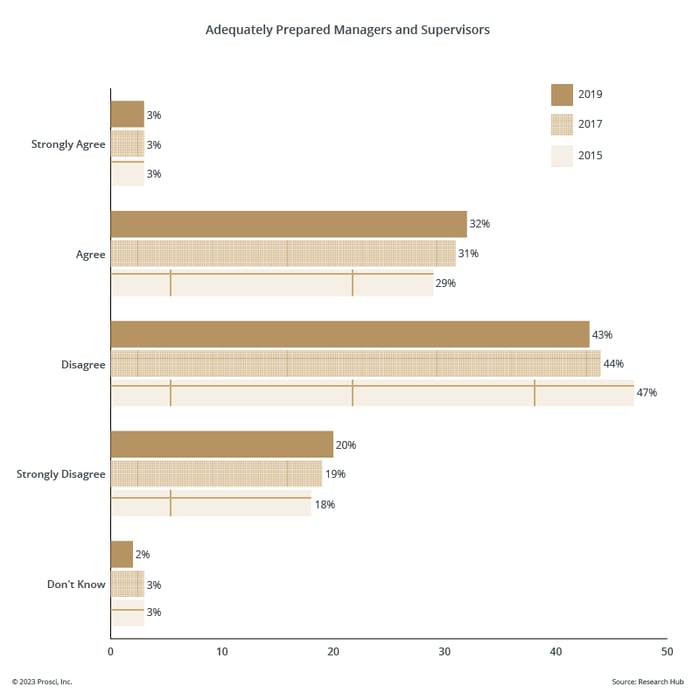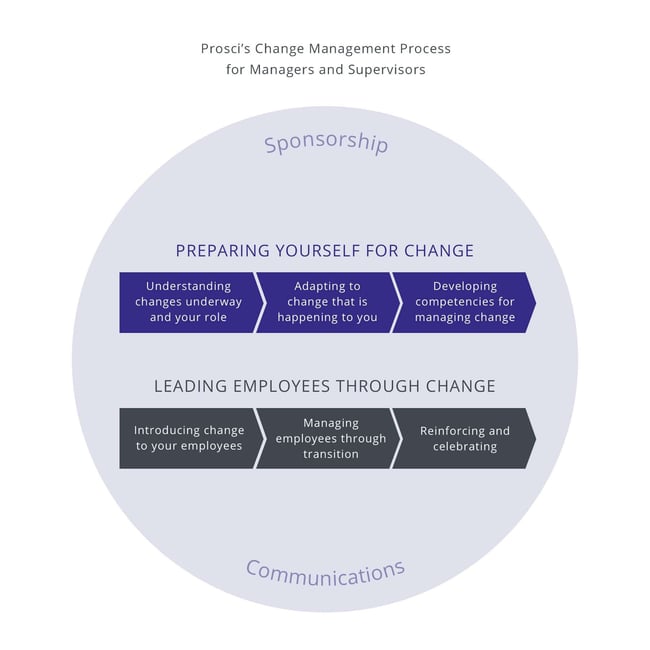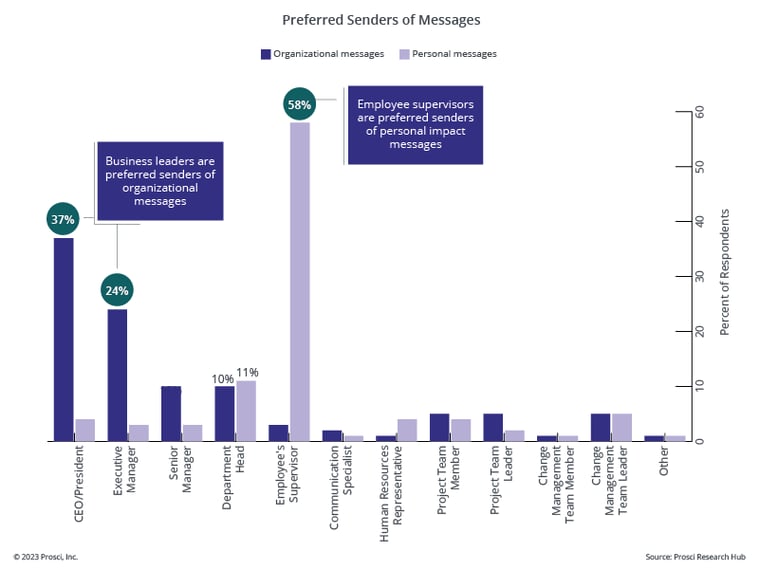CLARC: The Role of People Managers in Change Management
4 Mins
Updated: April 24, 2025
Published: June 28, 2021

People managers are critical to the success of any change initiative. As the individuals closest to the front-line employees who must adopt new processes and behaviors, they can be significant allies or significant obstacles to change success.
Usually, change impacts the way people managers do their own work too. If the people manager is not on board with a change, how can we expect them to support it with their teams? It is the change leader's job to influence the Desire of people managers to support a change and lead their team through it. To do that, people managers must understand their five critical CLARC roles, how to perform them, and how each role connects to the ADKAR Model.
Importance of People Managers
Engagement with people managers has been named a top contributor to change management success in Prosci's Best Practices in Change Management benchmarking research since 2011. People managers are crucial to change success because of their relationship and proximity to employees affected by change. Prosci research shows that a majority of employees prefer to receive personal messages about changes directly from their managers, who are well positioned to help employees move through their individual ADKAR journeys.
5 CLARC Roles
Effective communication by people managers is necessary but not sufficient to drive successful change adoption. Prosci research shows that people managers have five unique and important roles to play during times of change:
- Communicator – Share personal impact messages with direct reports about the change
- Liaison – Engage with and support the project team
- Advocate – Demonstrate support for the change
- Resistance Manager – Identify and mitigate resistance to the change
- Coach – Help employees through the change process
CLARC and ADKAR
Fulfilling each of the CLARC roles enables a people manager to have a positive impact an individual's journey through each stage of the ADKAR Model: Awareness, Desire, Knowledge, Ability and Reinforcement.
1. Communicator
As a communicator, the people manager builds Awareness of the need for change with their team.
Employees want to receive messages about how a change will affect their work and team directly from the person they report to. An employee's supervisor is the conduit for information about the organization, work being done, and changes to that work as a result of projects and initiatives. Answers to the following questions are best delivered by a person's immediate manager:
- What does this change mean to me?
- What's in it for me?
- Why should I get on board?
- Why are we doing this?
The change management team should provide talking points and essential details, but the people manager should deliver the messages and answer questions from their team members.
2. Liaison
As a liaison, people managers influence Reinforcement to sustain the change,
People managers engage with and liaise between their employees and the project team, providing information from the team to their direct reports. Perhaps more importantly, they provide feedback from their employees to the project team. Managers are in the best position to provide design input, usability results and employee comments on particular aspects of the solution to the project team. They are also positioned to identify functionality needs and concerns during the implementation phase of the project.
3. Advocate
As an advocate, people managers influence Desire to participate and support the change.
Employees look to their immediate supervisors for direct communication messages about a change and to evaluate their level of support for the change effort. If a people manager only passively supports or even resists a change, their direct reports will likely do the same. This means that people managers need to demonstrate their support for change in active and observable ways.
But first they must engage with and support the change as employees. Change practitioners enable this by creating targeted and customized tactics for managing the change with people managers. Once they are well-equipped for the change, people managers can then effectively guide others through their individual change journeys.
4. Resistance Manager
When fulfilling the role of resistance manager, people managers influence an employee’s Desire to participate and support a change, as well as Reinforcement to sustain the change.
To manage resistance, people managers are in the best position to proactively define what resistance looks like for their group, the root causes of such resistance, and unique barriers to change. They can then offer solutions to help impacted people address the barriers. When people managers have the right training and tools, they also manage resistance as it occurs.
5. Coach
The coach role focuses on developing Knowledge on how to change, as well as Ability to implement required skills and behaviors.
People managers coach individual employees throughout the change, providing the necessary training, information and support they need to effectively adopt and use the change. During coaching activities, people managers may also address barrier points that inhibit successful change.
Manager and Supervisor Preparedness
Participants in the Best Practices in Change Management - 12th Edition study evaluated their organizations' efforts to adequately prepare people managers to fulfill the CLARC roles. Although preparedness has improved marginally since 2015, 63% of respondents feel their organization does not adequately prepare people managers with the skills, training and tools they need to lead during change.
 For many people managers, the roles of coach and resistance manager represent the biggest departure from the role they have historically played in the organization. Effectively coaching employees through a change, and identifying and managing resistance to change, requires new skills.
For many people managers, the roles of coach and resistance manager represent the biggest departure from the role they have historically played in the organization. Effectively coaching employees through a change, and identifying and managing resistance to change, requires new skills.
This research finding should set off warning bells for change practitioners. Although people managers are consistently identified as critical to successful change, they are not being prepared and equipped with the skills, training and tools they need to fulfill their key CLARC roles.

Equip People Managers for Change
As a change practitioner charged with enabling employee-facing roles for change within your organization, your role is to prepare, equip and support people managers to fulfill their CLARC roles. A people manager who has been well-equipped can clearly articulate their responsibilities in plain language:
"I, the people manager for this change, contribute to successful change outcomes
(through adoption and usage) by performing the roles of Communicator, Liaison, Advocate, Resistance Manager and Coach."
As a starting point, ask:
- Have we told people managers what we expect from them in times of change?
- Do they fully understand the specific actions and behaviors we need from them to support a change effort?
- Have we enabled them with the skills and tools they need to be successful at leading their people and teams through change?
If you answer "no," the changes your people managers are expected to lead are unlikely to be successful. To rectify the problem, consider how you can build awareness of the need for people managers to play their important role in times of change. Then equip them with the skills and frameworks they need to help themselves and their people move through change successfully.





